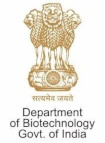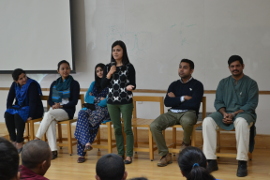Postdoctoral fellows - Lecture Series in Advanced Biology 2020 Theme: Evolution of Systems across timescales
Lecture Series in Advanced Biology 2020 Theme: Evolution of Systems across timescales
Co-ordinators: Anusha Jahagirdar, Bhaktee Dongaonkar, Dhananjay Chaturvedi, Megan Aylward, Rashmi Sharma, Renjitha Gopurappilly, Sandeep Ameta, Shirish Mishra, Shruthi Balachandra, Sowmya Jahnavi, Sriram Varahan, Subhasri Ghosh, Vidya Ramesh
Date, time and venue: 2nd Feb to 22nd March 2020. Every Sunday from 9 am to 12 pm at NCBS, Bangalore.
Brief introduction:
Us Post Docs at NCBS put together an annual advanced lecture series for undergraduate students based on our own expertise. We know that nature can be complicated, but through the lens of science we can make it easier to understand. We go beyond the text book, presenting basic and relevant information across subjects to build up concepts and to encourage analytical thinking.
The theme for this year’s lecture series is “Evolution of systems across time scales”. The premise of biological evolution is simple but plays out in many different ways that make living systems complex. In this lecture series, we will discuss principles of evolution operating from molecules to eco-systems; for seconds to millions of years. We will discuss the basic principles that force molecules to interact in otherwise energetically unfavorable ways to make the building blocks of life. Once cells are made, how do they communicate with each other? Do cells retain legacy communication modules (a.k.a. signaling pathways) while developing new ones, as they transition to multicellular life forms? How did the biological apparatus to detect light, a pervasive environmental stimulus, evolve? How does the processor of environmental cues, the brain, differ among species? Do different life forms retain or parallelly develop means of repairing injury or handling stress? What happens when one species' life cycle interferes with that of another i.e. how do diseases evolve, and how can that knowledge be used for treatment? How does the environment control the formation of a new species?
This lecture series is tailored to later stage undergraduate students and they’re given preference during the selection process. However, the biggest factor contributing to selection is the answer to the screening question we pose. Please do spread the word to anyone who can possibly benefit. Looking forward to seeing you there.
Regstration link: https://forms.gle/

Teachers
Anusha Jahagirdar:
I am a post-doctoral fellow at inStem. My graduate studies involved developing therapies to target obesity by enhancing brown fat thermogenesis. Currently, I am studying the interplay of metabolites and protein translation in regulating stem cell biology.
Bhaktee Dongaonkar:
I am research scientist at NCBS. I study learning and memory processes in stress, depression, and aging in humans.
Dhananjay Chaturvedi:
As an undergrad I studied microbiology but switched to Development from my masters’ onwards. I’ve studied brain development in mice and stem cells in Drosophila. Most recently our group uncovered a novel stem cell population in Adult fly muscles which maybe the basis of muscle maintenance and repair. This whole journey in knowledge had been enriching and rewarding. I’d like to share some of what fascinates me.
Megan Aylward:
I am an evolutionary biologist studying the genetics of mammalian populations. My research centers around using DNA to understand historic processes that have shaped current populations. I am currently a post doc at NCBS studying the genomic effects of inbreeding in tigers.
Rashmi Sharma:
I got my PhD from CSIR-Indian Institute of Integrative medicine, where I worked on target-based drug discovery for identifying hits against resistant gram negative bacterial strains. Currently, I am working as a postdoctoral fellow with Dr Varadharajan Sundaradmurthy where my work is focussed on understanding host pathogen interaction between Mycobacterium tuberculosis and host macrophages by chemical modulation.
Renjitha Gopurappilly:
I work in Prof. Gaiti Hasan's group at National Centre for Biological Sciences, Bangalore, investigating the role of intracellular calcium signaling in human induced pluripotent stem cell (iPSC) and embryonic stem cell (ESC)-derived neural precursors and neurons in normal and diseased state. My work focuses on the use of 2D and the currently emerging 3D organoid system to model human brain development and to understand neurodegenerative disorders.
Sandeep Ameta:
I am an experimentalist interested in Origins of Life (OoL) problems. My work revolves around studying RNA catalysis and chemical self-replicating systems using interdisciplinary and high throughput approaches. In my postdoc, I worked on one of the fundamental questions of origins of life: ‘Can life begin as self-sustaining networks?’. To approach this problem, I built an experimental system using droplet-based microfluidics combining with single-cell sequencing (inDrop, Drop-Seq). Here at the Simons Centre NCBS, I am working on the exciting problem of experimentally demonstrating the emergence of autocatalytic networks from the library of diverse RNA fragments.
Shirish Mishra:
I completed my PhD at the University of Fribourg, Switzerland (2010- 2015) where I was involved in the understanding of the relationship of lipid droplets (LDs) with endoplasmic reticulum (ER) in budding yeast Saccharomyces cerevisiae. Currently, as a postdoctoral fellow in the Raghu Padinjat lab at NCBS, Bangalore (http://flyfat.ncbs.res.in/), I am working to understand the regulation of lipid transfer activity and ER-PM contact sites.
Shruthi Balachandra:
I am a Postdoctoral Fellow working with Dr. Tina Mukherjee, inStem. I started my research carrier as an evolutionary biologist, and now continuing my research carrier as a cell biologist. Diverse experience through my carrier has made me appreciate how evolution can be biased. During my Ph.D. research I focused on divergence of sexual traits driving towards speciation; whereas from the past few years, I'm trying to understand how basics cellular processes maintaining cellular/systemic homeostasis share commonness across the different strata of the organisms.
Sowmya Jahnavi:
Transition from being a microbiologist to a stem cell biologist has helped me appreciate various aspects of science of living forms. It is very interesting to observe how life at different levels chooses to meet any circumstance and make decisions. During the process of my career as a researcher, I have learnt to study fate choices during development across cellular lineages using adult stem cells as models, what kind of external signals or challenges affect cell decision-making and what kind of internal circuitry a cell adopts to survive such stimuli. I am currently looking at one such regulatory landscape: the lipid machinery of cells. Specifically, my current work at NCBS is related to changes in lipid biology of the plasma membrane of a cell in response to external signals. One such signal I am going to address during the lecture series is dietary input.
Sriram Varahan:
I got my PhD from the University of Kansas, USA where I looked at peptide pheromone signaling in bacterial biofilms (communities). Community behavior of cells has always fascinated me and when I joined the lab of Dr. Sunil Laxman at inStem, I decided to look at metabolic principles that drive the development of communities in the model organism yeast. We have identified some fundamental metabolic constraints that drive the development of yeast communities.
Subhasri Ghosh:
I am a postdoctoral research fellow at inStem, studying stem cell responses during wound-healing in the skin. I use cell culture techniques, biochemical methods and mouse models for my experiments. As a graduate student, at NCBS, I studied the process by which plasma membrane associated cortical actin filaments organize membrane molecular complexes at the nanoscale.
Vidya Ramesh:
I am a neuroscientist at InStem, NCBS. I have previously worked on studying the mechanisms underlying mammalian brain development. My current research is focused on using human stem cell technology to model neurodevelopmental disorders occurring in humans, such as autism.


